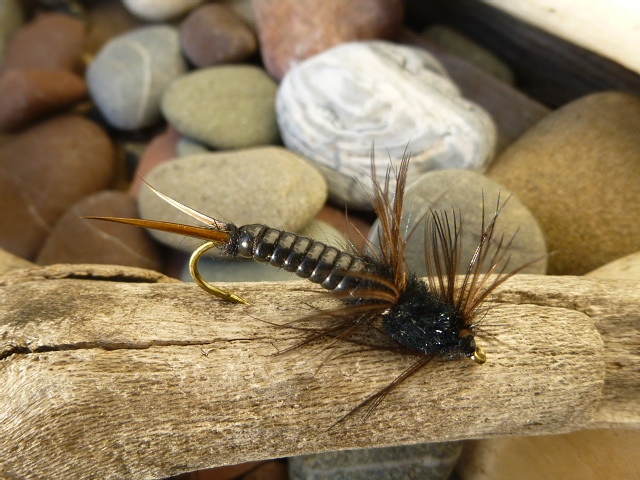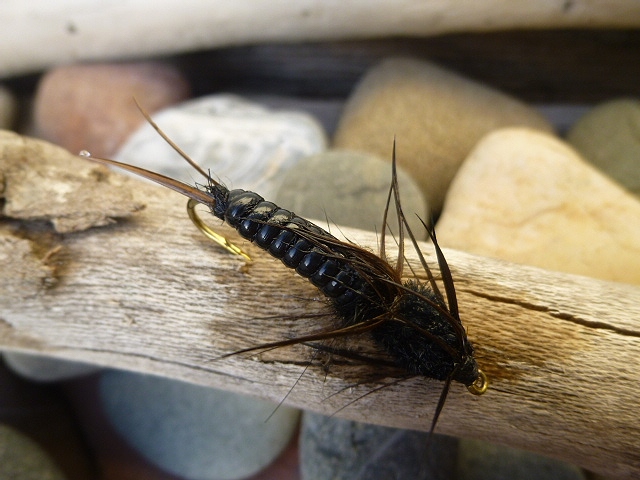 |
| Salmonfly Nymph tied by Steven Bird |
Probably everybody in the
West who has fished a freestone stream has at least a passing knowledge of the
giant stonefly, Pteronarcys californica, commonly
known as the ‘salmonfly’. A close look at streamside rocks & bushes May & June will usually reveal the empty husks of recently emerged stoneflies,
& some of these may be nearly two inches long.
Salmonflies inhabit well-oxygenated
flows with gravel/rubble bottoms. Most any freestone stream in the West will
harbor some, though medium to large rivers will produce the strongest hatches. I love fishing dry versions of this stonefly when trout are up & feeding on them, but, day-in, day-out, I take more fish on the nymph during the salmonfly hatch period. And not only during the emergence period, but as a big-fish pattern, year
around. This stonefly species lives two to three years instream as a nymph before
crawling out of the water to complete emergence to adult, so there are always
at least three age groups of various sizes available to trout.
Stonefly nymphs are strong
crawlers but lousy swimmers. Emergence occurs April-June, with May probably the
most prolific month in most locales. For several weeks prior to emergence, nymphs
become very active & bold, & trout will be taking advantage of the many
exposed & busted loose drifting in the current. The imitation wants to be
fished deep, dead-drifted or crawled on the bottom, so I weight them with
copper fuse wire wound through the thorax area of the hook shank.
There was a time I fished a
simple, large, black Wooly Worm to simulate the salmonfly nymph (still an effective pattern), yet when I read Charles Brooks, Nymph Fishing For Larger
Trout, I became intrigued with his version of the giant stonefly nymph which
utilizes two soft hackles installed fore & aft of the thorax. I tied some
& fished them to excellent result on the Thompson River, in Montana .
The pattern shown here is the one I’m using now, inspired by the Charles Brooks
pattern.
Soft-Hackle Salmonfly Nymph
Hook: #4-#6
TMC 200R
Thread: Black
(I use 3/0 uni-thread to get quick build-up to form the body shape.)
Tails: Two
dark brown or black goose biots, divided, one on either side of the hook shank –
wrap a turn or two of black dubbing before tying in, to keep tails spread wide
Ribbing:
Black D lace wound over the abdomen to create segmentation
Abdomen: Black
yarn overwrapped with black D lace to slightly ahead of center – a considerable
lump will be formed when the plastic lace is wrapped & snipped off, wind
over the bump with black dubbing
Rear Hackle:
One turn of bronze-black body feather taken from a cock ringneck pheasant (These
are blackish with bronze & reddish highlights.)
Thorax: Black
chenille
Front Hackle: Same
as rear hackle
Head: A bit
of black dubbing ahead of the front hackle – you may add a couple of biots or pheasant
tail fibers here as antennae – & finish
Flyfish the Upper Columbia/NE Washington with Steven Bird: http://ucflyfishing.blogspot.com
Flyfish the Upper Columbia/NE Washington with Steven Bird: http://ucflyfishing.blogspot.com
 |
| Salmonfly Nymph - Steven Bird |